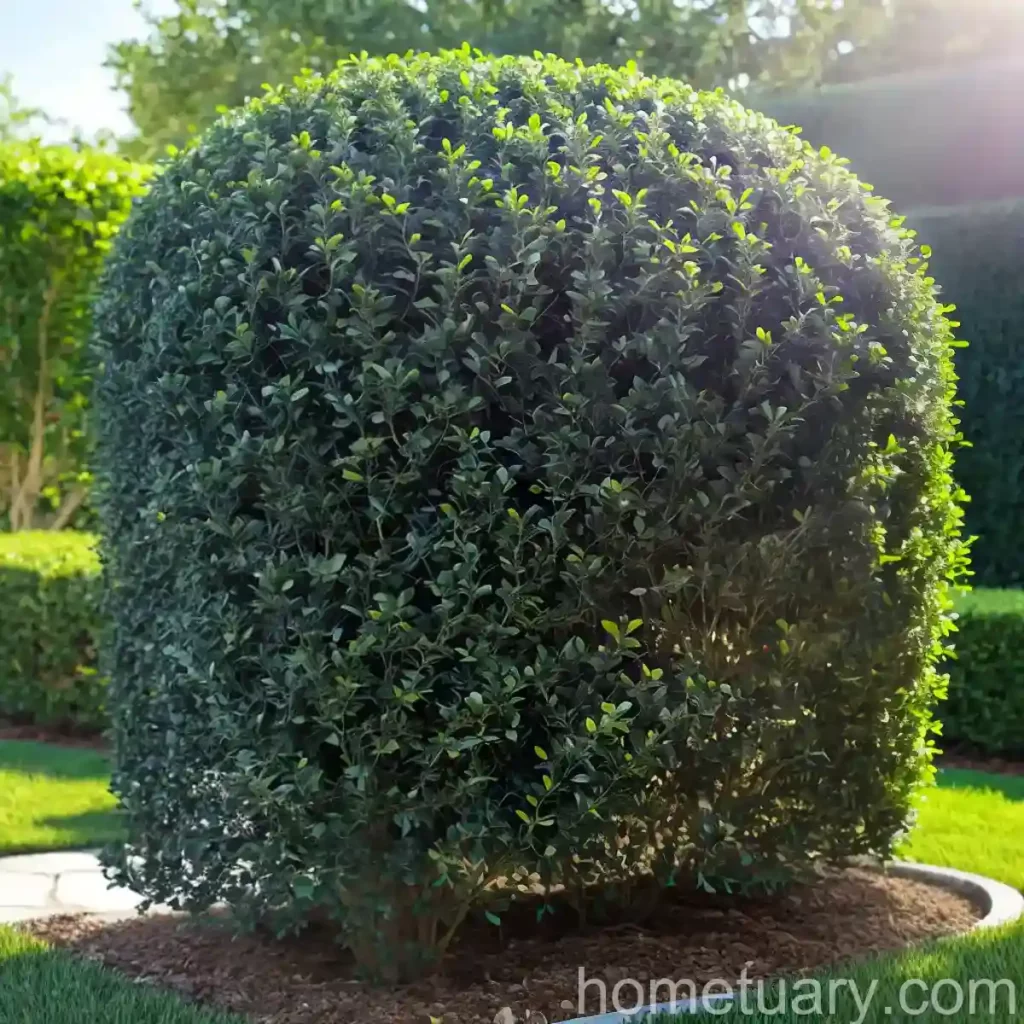The Beauty of Border Privet (Ligustrum obtusifolium)
As a plant scientist and enthusiast, I have come across a wide array of plant species, each with its unique attributes and contributions to the environment. Among these, the border privet (Ligustrum obtusifolium) has particularly captured my attention for its versatility, resilience, and aesthetic appeal. In this comprehensive guide, we will delve into the culture, uses, care, and maintenance of border privet, shedding light on its significance in landscaping, ecological benefits, and much more.
What is Border Privet (Ligustrum obtusifolium)?
Border privet, scientifically known as Ligustrum obtusifolium, is a species of privet native to Japan and Korea. It is a deciduous shrub that belongs to the Oleaceae family and is widely admired for its ornamental qualities, making it a popular choice for hedges, borders, and landscaping projects. The plant is characterized by its dense foliage, fragrant white flowers, and dark blue-black berries, adding visual interest and ecological value to outdoor spaces.
Key Takeaways – Border Privet (Ligustrum obtusifolium)
As we explore the various aspects of border privet, I will address the following key takeaways related to its culture, uses, and maintenance:
- Culture
- Uses
- Water
- Sunlight
- Fertilizer
- Soil
- Pruning
- Propagation
- Container Popularity
- Common Diseases
- Disease Diagnosis
- Common Pests
- Botanist’s Tips
- Fun Facts
- Links to External Resources
Now, let’s embark on an in-depth exploration of each of these aspects to gain a comprehensive understanding of border privet.
Culture
Growing Border Privet
Border privet (Ligustrum obtusifolium) is known for its adaptability to various soil types and environmental conditions, making it an excellent choice for both novice and experienced gardeners. When cultivating border privet, it is essential to consider the following cultural factors to ensure the plant’s optimal growth and health:
-
Sunlight: Border privet thrives in full sun to partial shade, making it suitable for a wide range of outdoor environments. However, it is important to provide adequate sunlight for the plant to promote robust growth and flowering.
-
Water: While border privet is relatively tolerant of drought conditions, it is essential to provide regular watering, especially during the establishment phase. Deep, infrequent watering is preferred to encourage deep root development and overall plant resilience.
-
Soil: This versatile shrub exhibits a preference for well-drained, loamy soil with a slightly acidic to neutral pH. Amending the soil with organic matter can improve its structure and fertility, promoting the plant’s vitality and longevity.
-
Fertilizer: Border privet responds well to balanced fertilization, particularly in early spring before the onset of new growth. A slow-release, general-purpose fertilizer applied according to the manufacturer’s instructions can support the plant’s nutritional needs and overall vigor.
Ligustrum Obtusifolium Shrub
The shrub form of Ligustrum obtusifolium is characterized by its dense and compact growth habit, making it an ideal candidate for hedging, screening, and shaping into formal or informal landscapes. The shrub’s versatility and resilience allow it to thrive in diverse climatic conditions, from temperate to subtropical regions, adding to its widespread popularity among gardeners and landscapers alike.
Privet Hedge Border
One of the most notable uses of border privet is in the creation of hedges and borders, where its dense foliage and fast growth make it a favorite choice for defining outdoor spaces, providing privacy, and enhancing the aesthetic appeal of gardens and landscapes. When utilized as a hedge border, border privet offers a classic and timeless look, whether maintained as a formal hedge or shaped into more free-form designs.
Border Privet Planting Tips
When planting border privet, it is essential to consider the following tips to ensure successful establishment and long-term growth:
-
Spacing: Plant border privet at an appropriate spacing to allow for sufficient airflow and future growth. Typically, spacing the plants 2-3 feet apart is recommended for creating a dense hedge or border.
-
Planting Depth: Ensure that the shrubs are planted at the same level as they were in the nursery containers. Backfill the planting holes with amended soil and water thoroughly to eliminate air pockets around the roots.
-
Mulching: Apply a layer of organic mulch around the base of the newly planted shrubs to conserve soil moisture, suppress weed growth, and provide insulation against temperature fluctuations.
Ligustrum Obtusifolium Maintenance
In terms of maintenance, border privet (Ligustrum obtusifolium) requires regular care to preserve its health and aesthetic appeal. Key maintenance practices include:
-
Pruning: Regular pruning is essential to shape the shrub, control its size, and promote flowering and fruiting. Pruning can be carried out in late winter or early spring before the onset of new growth, with subsequent light trimmings throughout the growing season as needed.
-
Watering: While border privet exhibits some drought tolerance, supplemental watering during periods of prolonged dryness is beneficial, particularly for newly planted shrubs and during hot summer months.
-
Fertilization: Apply a balanced, slow-release fertilizer in early spring to provide the shrubs with essential nutrients for vigorous growth and flowering. Avoid over-fertilization, as excessive nitrogen can lead to excessive vegetative growth at the expense of bloom production.
-
Mulching: Maintaining a 2-3 inch layer of mulch around the base of border privet shrubs can help conserve soil moisture, regulate soil temperature, and reduce competition from weeds.
Uses
Privet Border Plant Varieties
The border privet (Ligustrum obtusifolium) is valued for its versatility and can be utilized in various landscape settings and designs. Some popular uses of border privet include:
-
Formal Hedges: When planted in a row and regularly trimmed, border privet can create formal hedges with a tidy and tailored appearance, offering structure and defining boundaries in the landscape.
-
Informal Hedges: The shrub’s natural growth habit and lush foliage make it well-suited for informal hedges, where it can be allowed to grow more freely, creating a relaxed and naturalistic border for outdoor spaces.
-
Garden Borders: Border privet can be planted as a living border to delineate garden beds, pathways, or property lines, enhancing the overall aesthetics and organization of the landscape.
-
Screening Plants: The dense foliage and moderate height of border privet make it an effective screening plant, providing privacy and seclusion in residential and commercial settings.
Border Privet Hedge Benefits
The utilization of border privet as a hedge offers several notable benefits, including:
-
Privacy: By forming a dense and leafy barrier, border privet hedges provide privacy and seclusion, effectively shielding outdoor spaces from adjoining properties, roads, or undesirable views.
-
Aesthetic Appeal: Whether maintained as a formal or informal hedge, border privet adds visual interest to the landscape, with its vibrant foliage, fragrant blooms, and attractive berries contributing to the overall beauty of the garden.
-
Wildlife Habitat: The dense foliage and berries of border privet attract birds and beneficial insects, creating a valuable habitat for wildlife within the urban and suburban landscape.
Privet Border Landscaping Ideas
When incorporated into landscaping, border privet offers numerous design possibilities, adding texture, structure, and functionality to outdoor environments. Some creative landscaping ideas for border privet include:
-
Mixed Hedges: Combine border privet with other hedge plants, such as boxwood, holly, or viburnum, to create layered and visually appealing mixed hedges that provide year-round interest.
-
Topiary and Shaping: Border privet can be pruned and shaped into topiaries, geometric forms, or whimsical designs, adding a touch of artistry and sophistication to the garden.
-
Naturalistic Plantings: In informal or cottage-style gardens, border privet can be planted en masse, creating flowing borders and undulating drifts of foliage for a relaxed and naturalistic appeal.
-
Architectural Accents: Utilize border privet to create architectural focal points, such as entrance columns, parterres, or boundary markers, adding structure and definition to the landscape.
Water
Border Privet Water Needs
When it comes to water requirements, border privet (Ligustrum obtusifolium) demonstrates moderate drought tolerance once established, making it suitable for landscapes with varying moisture levels. Understanding the water needs of border privet is essential for promoting healthy growth and overall vitality.
Privet Border Watering Guidelines
To ensure adequate moisture for border privet while avoiding waterlogged conditions, consider the following watering guidelines:
-
Establishment Phase: Newly planted border privet shrubs require regular watering to support root establishment and initial growth. Provide 1-2 inches of water per week for the first growing season, adjusting based on local precipitation and soil moisture levels.
-
Mature Plants: Once established, border privet can tolerate periods of drought, but supplemental watering may be necessary during extended dry spells, especially in hot and arid climates. Water deeply, allowing the soil to dry out slightly between waterings to encourage robust root development.
-
Seasonal Considerations: Increase watering frequency during hot summer months or in windy, exposed locations, as these conditions can accelerate soil moisture depletion and impact the shrub’s overall health.
-
Signs of Stress: Monitor the shrubs for signs of moisture stress, such as wilting, yellowing foliage, or leaf drop, and adjust watering practices accordingly to maintain their vigor and resilience.
Sunlight
Border Privet Sun Requirements
Sunlight is a crucial factor influencing the growth, flowering, and overall performance of border privet (Ligustrum obtusifolium). Understanding the sun requirements of the shrub is essential for selecting suitable planting locations and providing optimal growing conditions.
Privet Border Sun Exposure
Border privet demonstrates a preference for full sun to partial shade, making it adaptable to a range of light conditions. Consider the following sun exposure guidelines when cultivating border privet:
-
Full Sun: Plant border privet in locations that receive at least 6-8 hours of direct sunlight per day to promote vigorous growth, abundant flowering, and the development of dense foliage.
-
Partial Shade: While border privet can tolerate partial shade, it is important to ensure that the shrubs receive adequate sunlight to prevent reduced flowering, sparse foliage, and potential leggy growth.
-
Site Selection: When selecting planting sites, consider the orientation of the garden, potential shading from nearby structures or trees, and the presence of obstructions that may impact sunlight availability.
-
Adaptability: Border privet’s adaptability to varying light conditions enables its successful integration into diverse landscapes, from open, sun-drenched areas to partially shaded garden beds.
Fertilizer
Ligustrum Obtusifolium Fertilizer Recommendations
Applying a balanced fertilizer to border privet can support its growth, flowering, and overall vitality. Understanding the fertilizer needs and recommendations for border privet is essential for promoting healthy and resilient shrubs in the landscape.
Privet Border Fertilization Guidelines
When fertilizing border privet, consider the following guidelines to provide the shrubs with essential nutrients without overstimulating growth:
-
Timing: Apply fertilizer in early spring, just before the onset of new growth, to support the shrub’s nutritional needs as it enters the active growing season.
-
Fertilizer Type: Use a balanced, slow-release fertilizer with an N-P-K ratio suited for woody plants, such as 10-10-10 or similar formulations. Avoid high-nitrogen fertilizers that may promote excessive vegetative growth at the expense of flowering and fruiting.
-
Application Rate: Follow the manufacturer’s instructions regarding the application rate for the specific fertilizer product used, typically based on the shrub’s size and age. Apply the fertilizer evenly around the drip line of the shrub and water thoroughly to facilitate nutrient uptake.
-
Frequency: For established border privet shrubs, an annual application of fertilizer in early spring suffices to meet their nutritional requirements. Avoid excessive or frequent fertilization, as it can lead to nutrient imbalances and potential harm to the shrubs.
-
Soil Amendments: If the soil exhibits deficiencies in key nutrients or pH imbalances, consider incorporating organic matter, compost, or targeted soil amendments to improve its fertility and structure, thereby enhancing the shrub’s overall health and vigor.
Soil
Privet Border Soil Preferences
Border privet (Ligustrum obtusifolium) thrives in well-drained soil with a slightly acidic to neutral pH, making it adaptable to a wide range of soil types and conditions. Understanding the soil preferences of border privet is crucial for creating an optimal growing environment and promoting the shrub’s long-term health.
Ideal Soil Characteristics
When cultivating border privet, aim to provide the following soil characteristics to support the shrub’s growth and vitality:
-
Drainage: Ensure that the soil offers good drainage to prevent waterlogging, root suffocation, and the development of excessive moisture-related issues. Amending heavy clay or poorly drained soils with organic matter can enhance drainage and aeration.
-
pH Level: Aim for a slightly acidic to neutral soil pH in the range of 6.0-7.0, as this pH range is conducive to optimal nutrient uptake and promotes the overall health and vigor of border privet shrubs.
-
Soil Structure: Border privet benefits from well-structured, loamy soil that provides a balance of air space, water retention, and nutrient availability. Incorporating organic matter can improve soil structure, fertility, and microbial activity, fostering a hospitable environment for the shrubs’ root systems.
-
Soil Texture: While border privet is adaptable to various soil textures, it generally thrives in loamy or sandy loam soils that offer a favorable balance of drainage and water retention, promoting root development and overall plant resilience.
Pruning
Ligustrum Obtusifolium Pruning Techniques
Pruning is an essential maintenance practice for border privet, enabling gardeners and landscapers to shape the shrubs, promote flowering, and manage their size and density. Understanding the pruning techniques and recommendations for border privet is essential for preserving the shrubs’ health and ornamental characteristics.
Privet Border Pruning Guidelines
When pruning border privet, consider the following guidelines to achieve desired shapes and promote the shrubs’ long-term vitality:
-
Timing: Prune border privet in late winter or early spring, before the onset of new growth, to encourage branching, flowering, and the development of dense foliage. Additional light trimmings can be carried out throughout the growing season as needed to maintain the desired shape and size.
-
Tool Selection: Use high-quality pruning shears, hedge trimmers, or loppers for precision pruning, ensuring that the cutting blades are sharp to make clean, smooth cuts that minimize damage to the shrubs.
-
Shaping: When shaping border privet, aim to maintain a tapered, wider base that allows sunlight to reach the lower branches, promoting even growth and foliage density from top to bottom.
-
Size Control: Regular pruning helps control the size and density of border privet, preventing it from becoming overgrown and maintaining its aesthetic appeal and functionality as a hedge or border plant.
-
Health Maintenance: Remove dead, damaged, or diseased wood to promote the shrub’s overall health, vigor, and resistance to pests and disease. Thin out dense growth to improve air circulation and light penetration into the interior of the shrubs.
-
Pruning Strategy: Consider the intended purpose of the border privet (e.g., formal hedge, informal border, topiary) and apply appropriate pruning strategies to achieve the desired look and functionality.
Propagation
Privet Border Propagation Methods
Propagation allows gardeners to expand their border privet collection and create new plants from existing shrubs. Understanding the propagation methods and techniques for border privet is essential for successfully obtaining new plants from seeds, cuttings, or other reproductive means.
Border Privet Propagation Techniques
When propagating border privet, consider the following methods and techniques to achieve successful results:
-
Seed Propagation: Collect ripe berries from border privet shrubs and extract the seeds for sowing. Stratify the seeds by cold treatment to break dormancy and then sow them in nursery pots or seed trays filled with a well-draining, sterile potting mix. Keep the soil consistently moist and provide warmth and light for germination.
-
Cutting Propagation: Take softwood or hardwood cuttings from healthy, disease-free border privet shrubs, 4-6 inches in length, and remove the lower leaves. Dip the cut ends in a rooting hormone to encourage the development of roots, then plant the cuttings in a soilless rooting medium or pre-moistened potting mix. Provide warmth, humidity, and bright, indirect light for the cuttings to root successfully.
-
Division: Border privet shrubs can be propagated through division, especially when they have developed multiple stems and root clusters. Carefully lift the shrubs from the ground, exposing their root systems, and use a sharp, clean tool to divide them into smaller sections with healthy roots and stems. Replant the divisions at appropriate spacing and provide adequate care to support their establishment and growth.
-
Layering: Encourage border privet to form new roots by layering a low-growing branch or stem directly onto the ground or into a container of moist soil, securing it in place and ensuring that the area is kept consistently moist. Once the layered section has developed roots, it can be separated from the parent plant and transplanted to a new location.
Container Popularity
Border Privet in Containers
The versatility and adaptability of border privet (Ligustrum obtusifolium) extend to its potential for container cultivation, making it a desirable choice for patio, balcony, and urban gardens. Understanding the considerations and benefits of growing border privet in containers is essential for maximizing its ornamental value in small or confined spaces.
Advantages of Container Cultivation
Growing border privet in containers offers several advantages, including:
-
Space Efficiency: Containerized border privet can thrive in limited garden spaces, such as patios, balconies, and rooftop gardens, adding greenery and visual appeal to urban and confined environments.
-
Portability: Containers allow for the mobility and repositioning of border privet shrubs, enabling gardeners to experiment with different layouts and settings to suit their design preferences and seasonal requirements.
-
Design Flexibility: Border privet in containers can serve as standalone specimens, focal points, or components of mixed plantings, contributing to diverse design possibilities and creative expression.
-
Accessibility: Containerized border privet is conveniently accessible for care, maintenance, and observation, making it an ideal choice for gardening enthusiasts with limited mobility or space constraints.
-
Seasonal Display: Containerized border privet can be incorporated into seasonal displays, such as mixed planters, annual arrangements, or holiday-themed designs, enhancing the visual interest and versatility of outdoor spaces.
Common Diseases
Disease Prevention and Management
Like many plants, border privet (Ligustrum obt















